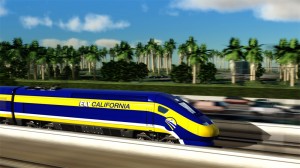 Google made headlines recently for buying a huge property adjacent to the future downtown San Jose high speed rail station, per the San Francisco Chronicle:
Google made headlines recently for buying a huge property adjacent to the future downtown San Jose high speed rail station, per the San Francisco Chronicle:
Google has been in negotiations with San Jose since June for a planned “village” that would feature up to 6 million square feet of office, research and development, retail and amenity space near San Jose’s Diridon Station. The development could bring 15,000 to 20,000 jobs, Nanci Klein, San Jose’s assistant director of economic development, previously told The Chronicle.
To be sure, this property would be valuable for Google even without high speed rail, as it’s at the heart of San Jose’s light rail network. But high speed rail will only increase the value, as it would give Google employees high-speed train access to businesses to the south and through the San Joaquin Valley — and eventually Los Angeles.
So the question is: would a property owner like Google be willing to help finance high speed rail, which is badly in need of cash? It’s the old school way of funding trains: leverage the future increases in property values around the stations to finance the transportation.
Given the slow trickle of state dollars and nonexistent federal funds, high speed rail leaders will need to get creative about how to find money to keep construction going. A large company like Google could greatly help with the search.
Yesterday we had a fascinating discussion of the respective rail transit histories of San Jose and Los Angeles at SPUR San Jose, with a bunch of high speed rail tidbits thrown in.
It was a particular pleasure to hear from Rod Diridon, who is basically the father of rail transit in Santa Clara County, from the VTA light rail line to the under-construction high speed rail (slated to come to San Jose in the next decade or so).
Some takeaways from San Jose/Santa Clara County’s rail transit history:
- County leaders achieved a 56% voter approval on a local sales tax initiative to launch rail back in the 1970s, partly in response to a prominent New York Times article calling San Jose the worst planned city in the country, partly due to the highly educated technology workers coming to the area, and mostly due to strong leadership at the local, state and federal levels.
- The local measure required public review of the system development every four years, which in practice meant a ton of outreach to the public, which in turn resulted in widespread awareness of the system and much public buy-in. Part of this process involved colorful mailers sent to everyone in the millions, which also provided good advertising and elicited more political buy-in.
- Diridon noted the importance of steady local leadership. He, Congressman Norm Mineta, and State Senator Al Alquist occupied their positions at various levels of government in the area for decades, allowing each to take ownership of the transit system and ensure that projects were built on time and on budget.
We also touched on high speed rail. Diridon chaired the High Speed Rail Authority and is a big booster. He surprised me by saying that the first segment from San Jose to somewhere around Bakersfield will make money by turning the Valley into bedroom communities. My impression is that the daily fare (up to $80 in today’s dollars, roundtrip) will be cost-prohibitive for most people living in the Valley.
In response to a question about getting rail from Union Station in Los Angeles to Palmdale, Diridon admitted that the route to Palmdale, which will add 15 minutes to the total ride, was made only because L.A. leaders like Supervisor Antonovich and Mayor Villaraigosa insisted the train stop there. Otherwise, he said, they wouldn’t have gotten the train built. It’s further evidence of the sad political compromise on the route.
In an irony though, he said the recent decision to change the route to now serve San Jose first is because of that Palmdale stop. Horse ranchers along the path from Palmdale to Burbank/San Fernando don’t want the train coming through, so they’ve created enough hassle to make the High Speed Rail Authority hold off on the Southern California section for now.
All in all, lots to learn in comparing the rail journeys of the two cities, which will one day be linked by high speed rail.
San Jose and Los Angeles are similar urban areas, despite their population differences. Both are primarily auto-oriented (with San Jose sometimes derisively referred to as “L.A. without the beach”). And both have recently sought to transform themselves into rail-oriented cities in recent decades.
Today at land use think tank SPUR in San Jose, the Honorable Rod Diridon and I will trace the history of the two cities’ urban transformation at a lunchtime talk. Mr. Diridon has a long and distinguished career in urban transportation issues in the South Bay, with a Caltrain/light rail transit station named after him just outside of downtown (we graded the surrounding neighborhood a “B” in our Next 10/Berkeley Law October report grading station neighborhoods across California).
The event is free and begins at 12:30. More information can be found here. I hope you can join.


